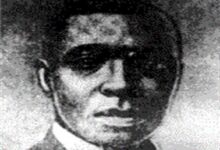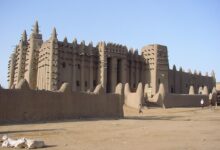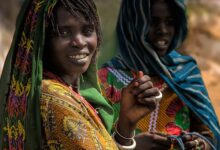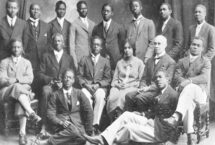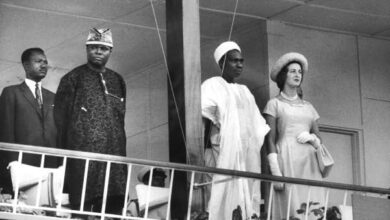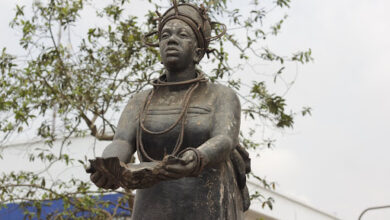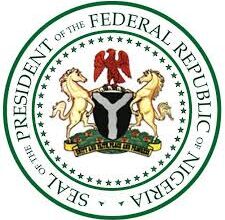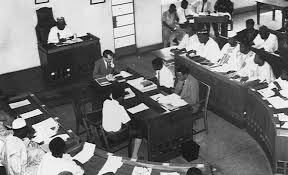Islam in West Africa: Introduction, spread and effects
The Almoravid Conquest of the Ghana Empire
According to Arab tradition, the Almoravids conquered the Ghana Empire sometime around 1076. An example of this tradition is the record of historian Ibn Khaldun, who cited Shaykh Uthman, the faqih of Ghana, writing in 1394. According to this source, the Almoravids weakened Ghana and collected tribute from Sudan to the extent that the authority of the rules of Ghana dwindled away, and they were subjected and absorbed by the Soso, a neighbouring people of Sudan. Traditions in Mali related that the Soso attacked and took over Mali as well, and the ruler of the Soso, Sumaouro Kante (Sumanguru Kante) took over the land.
DECLINE OF THE ALMORAVID DYNASTY
Three years afterwards, under Yusuf’s son and successor, Ali Ibn Yusuf, Sintra and Santarem in Portugal were added, and he invaded Iberia again in 1119 and 1121, but the tide had turned, as the French had assisted the Aragonese to recover Zaragoza. In 1138, Ali Ibn Yusuf was defeated by Alfonso VII of Leon, and in the Battle of Ourique (1139), by Afonso I of Portugal, who thereby won his crown. Lisbon was conquered by the Portuguese in 1147.
According to some scholars, Ali Ibn Yusuf provided a new generation of leadership that had forgotten the desert life for the comforts of the city. He was defeated by the combined action of his Christian foes in Iberia and the agitation of Almohads (the Muwahhids) in Morocco. After Ali Ibn Yusuf’s death in 1143, his son Tashfin Ibn Ali lost ground rapidly before the Almohads. In 1146 he was killed in a fall from a precipice while attempting escape after a defeat near Oran.
His two successors were Ibrahim Ibn Tashfin and Ishaq Ibn Ali, but their reigns were short. The conquest of the city of Marrakech by the Almohads in 1147 marked the fall of the dynasty, though fragments of the Almoravids (the Banu Ghanaiya,) continued to struggle in the Balearic Islands, and finally in Tunisia.
Military organization
Abdallah Ibn Yussin imposed very strict discipline measures on his forces for every breach of his laws The Almoravid first military leader, Yahya Ibn Umar al-Lamtuni, gave them a good military organization. Their main force was infantry, armed with javelins in the front ranks and pikes behind, which formed into a phalanx, and was supported by camel men and horsemen on the flanks. They also had a flag carrier as the front who guided the forces behind him, when the flag was upright, the combatants behind would stand and when it was turned down, they would sit.
Al-Bakri reports that, while in combat, the Almoravids did not pursue those who fled in front of them. Their fighting was intense and they did not retreat when disadvantaged by an advancing opposing force, they preferred death over defeat. These characteristics were possibly unusual at the time.
The Jakhanke Islamic Movement
A history of Islam in West Africa cannot be complete without a mention, however brief, of the Jakhanke Islamic Movement which arose in the 12th century under the charismatic scholar Alhajj Salim Suwareh who helped to spread Islam in the present-day countries of Mali, Guinea, Senegal and The Gambia, the most Islamized countries in West Africa today. The Jakhanke Islamization effort indeed have borne rich fruit! But let us begin by addressing the brass tacks: who were the Jakhanke? Why do they deserve attention in our study of the spread of Islam in West Africa?
The highly regarded Gambian historian Lamin Sanneh who is also the leading authority on the Jakhanke calls the Jakhanke a ‘specialized caste’ of Muslim clerics and educators. ‘Caste’ gives them an aura of belonging to a bigger group, the Serahuli ethnic group also called Soninke in other writings. Today, they are erroneously categorized as Mandinka. They speak a dialect of Mandinka, but their ‘Mandikanization’ was large because they were hosted by Mandinka chiefs when the Jakhanke moved from present-day Republic of Mali to the Senegambia region. ‘Clerics and educators’ indicate their profession as literate and therefore able to proselytize and do missionary work. Apparently, the Jakhanke who are found in the Senegambia region today in large numbers do not put much premium on their ethnic origins but rather on their work as propagators of Islam in the past 800 years.
This is exactly why the Jakhanke should interest us. They started a peaceful propagation of Islam in the Senegambia region. This is all the more relevant as we write today because of the rampant violence associated with Islam in many parts of the world. Much of the subsequent styles, and techniques associated with the peaceful spread of Islam in Senegambia is their creation. In a nutshell, they set the standards for missionary work.
What were these standards? Chiefly, they professed the peaceful path to Islam. They did not raise the sword to spread the religion. They resorted to more peaceful methods such as establishing Koranic schools and mosques, upgrading of mosques, holding sessions on Koranic exegesis, preservation of holy sites where yearly Islamic gatherings take place and being itinerant traders who took Islam to their clients and customers. But just as they had methods, they also had tactics! For example, they believed in numbers and therefore were keen to multiply their talibes or disciples. The disciples having gone through years of tutelage, would be allowed to disperse and then mass up new disciples themselves. Through massification, the Jakhanke helped to strengthen their religion. Also, they had a tactic of withdrawing into enclaves far from the maddening crowds, so to speak. Generally, Jakhanke needed the quietude of the monastery and thus were very good at establishing theocratic entities sometimes deep in the Senegambian Savannah, where they developed self sustaining communities dedicated to Islamic scholarship and renditions. Sutukuho, Sutukung, in The Gambia and Niokhlo and Suna Karantba in Casamance are extant examples of such religious villages.
So far absent in our discussion is the figure of Alhaji Salim Suwareh, the founder of the Jakhanke Islamic movement we have discussed above. He was a central in the success of the Jakhanke missionary work and therefore deserves our brief attention. His early life is shrouded in mystery, but a few strands deserve serious attention and are revealing. He died around 1500 and reputedly made seven pilgrimages to Mecca where he had relatives and lived before relocating to Black Africa to spread Islam, settling in the Jaka region of Masina, in present day Mali. Hence the name of his people Jakankhe, meaning in Mandinka ‘those who hail from Jaka’. When he completed his seventh hajj, he returned to Africa and stayed. He led his people from Jaka Masina to Jaka Bambuku. When the animist ruler of Bambuku became hostile, Suwareh did as the prophet of Islam did when Meccans started to throw stones at him: flee into exile. Suwareh led his band of talibes towards present day Senegambia. The historian Professor Sanneh writes that since this hijra or flight like movement, Jakhanke ‘have been united by a close bond of solidarity based on fidelity to Suwareh characterized by bonds of solidarity’.
So dedicated were the Jakhanke to the spirit of peaceful spread of Islam that when a Serahuli religious hothead, Momodou Lamin Drammeh(1835-1887) opted to wage war to convert Bundu (eastern Senegal) into Islam, the Jakhanke disowned him and fled further down to present eastern Gambia. His swashbuckling style was quite in contrast to their orderly ways of Islamization! Without bearing the sword, the Jakhanke were able to fasten the spread and reform of Islam in contrast to the jihadist like Drammeh, Umar Taal, or Maba Jahou Bah. The paradox here may not be obvious but is palpable: how Jakhanke whose mentor, Suwareh, lived and had relatives in Mecca could have disavowed the uncompromising Wahabi doctrine to espouse the ‘path of accommodation’?
To conclude therefore, what is the significance of the Jakhanke movement? Simply put, the Jakhanke epitomized peaceful and community led spread of Islam which made a deep impact on the recipient societies of Islam as the way of peace. The present day bomb throwers who claim to spread this religion by doing so may want to learn a lesson or two from the Jakhanke movement which started over 500 years ago
For further reading:
Ajayi, J..F.A and Michael Crowder History of West Africa. Vol. 2 Longman Group Ltd. London 1974
Ampadu B.K. Landmarks of African History to AD 1800 for Senior High School. NUUT Co. Ltd Kumasi Ghana 2012
Boahen, A.A. et al Tropics in West Africa History. Longman Group Ltd. Londonand Basingstoke 1986
Fage, J.D. A History of West Africa, Cambridge University Press 1969
Fynn , J.K. and R. Addo-Fening History for Senior Secondary schools. Evans Brothers, Ltd. London 1991
Insoll, T. The Archaeology of Islam in Sub-Saharan Africa. Cambridge: Cambridge University press. 2003
Levtzion, N. and J.F.P. Hopkins, Corpus of Early Arabic Sources for West African History, Cambridge, UK: Cambridge University Press. 2000 edition. 1981
Messier, R. A. Almoravids and the Meanings of Jihad, Santa Barbara, Calif.: praeger. 2010
Mones, H. “The conquest of North Africa and Berber resistance”, in M. Elfasi, ed., General History of Africa, Africa from the Seventh to the Eleventh Century, UNESCO. 1992 edition, Ch. 9, p. 224-46. 1988
THE SOKOTO CALIPHATE
Introduction
Created by a jihad launched by Usman dan Fodio (also spelt Usman Ibn Fodio, Uthman Dan Fuduye, or Uthman Ibn Fodio) between 1804 and 1810, the caliphate of Sokoto was the largest and most populated state of nineteenth-century Africa. According to a nineteenth-century account, it took four months to travel from west to east and two months to travel from north to south. The caliphate was organised as a decentralised state seeking to establish Islamic law over its large territory. The jihad and caliphate officially ended with the 1903 British conquest, but has since been widely studied and its legacy endures today, especially in Nigeria. Many observers have tried to understand the jihad, the caliphate and especially the figure of Usman dan Fodio. The jihad, itself at the origin of a rich Islamic scholarship, has now given place to a wide and varied literature.
The jihad and the creation of the caliphate
For dan Fodio, the main reason for the jihad was the purification of Islam in territories which were already Muslim at the beginning of the nineteenth century. The legitimacy of his struggle stemmed from his belief that, until this point, Muslim leaders had only practiced an impure form of Islam.
Some historians understood the jihad of Sokoto as a revolution because of the Hausa kingdoms’ socio-economical inequalities at the beginning of the nineteenth century. Dan Fodio’s success rests on his preference towards a form of equality and his proclaimed fight against corruption. As a champion of the people, dan Fodio launched his fight against the king and the aristocracy of Gobir in 1804. Even if the social dimension of the jihad should not be totally neglected, dan Fodio himself declared mainly religious reasons to be at the origin of the jihad in Kitab al-Farq. Correspondence exchanged with the leader of Borno in the 1800s is here revealing. After attempting to invade the kingdom that had existed since the ninth century, dan Fodio tried to convince Mohammed el-Kanemi of the religious and legal merits of his struggle. For dan Fodio, the jihad was mainly (but not only) conceived as a way of reforming lax Muslims by pure Muslims.
In the 1970s, some historians stressed an ethnic dimension in the jihad of Sokoto. According to this interpretation, dan Fodio was the descendant of Fulanis installed in Hausa regions since the fifteenth century, and would have pitted Islam against Hausas. However, even if most leaders of the Sokoto jihad were Fulani, it is difficult to argue that the numerically inferior Fulani would have believed that they could have overthrown the Hausa kings on exclusively ethnic grounds. Dan Fodio himself wrote against any ethnic discrimination in his treatise Bayan Wayan Wujub al-Hijra.
Scholars have also tried to show to what extent the jihad was not totally new in West Africa. Indeed discussions on the place of Islam in society had already taken place before the jihad of dan Fodio whether it was about food bans, marriage laws or clothes that women had to wear. It was this last point that had attracted the attention of Shaikh Jibril b. ‘Umar, one of the masters of Usman dan Fodio. Other jihads had already taken place in West Africa before that of dan Fodio (Bundu, late seventeenth century, Futa Jallon, 1725, Futa Toro, 1776). In other words, some Muslim scholars had already become reformers-conquerors before the advent of Usman dan Fodio.
The religious questioning of the jihad of dan Fodio was therefore not completely original. It is his lasting political victory over a vast territory that ensured his long-term success.
The structure and economy of the caliphate
The first six years of jihad (1804-1810) were fundamental in the creation of a political and religious foundation for a state that was never an empire, but a collection of territories under the authority of the caliph in Sokoto. Indeed the Caliphate of Sokoto was a highly decentralised state ruled by the Caliph. The Caliphate itself was a novel phenomenon in the Hausa regions and conferred moral and political authority on dan Fodio and his successors. Companions of the caliph, Fulani scholars who had become jihadists, were thus placed as emirs at the head of each territorial subdivision who answered directly to the caliph. Because of its size, the caliphate became divided between the western emirates under the authority of Sokoto and the eastern emirates which remained more or less autonomous.
The different successors of dan Fodio had to carry out military campaigns to assert their authority, thus making jihad a virtually uninterrupted phenomenon until the mid-nineteenth century. Mohammed Bello, dan Fodio’s son and direct successor, took the title of sultan and led many campaigns which he likened to the conquest of the Arabian Peninsula by the first Muslims in the seventh century. Bello’s policy consisted of appointing family members as heads of frontier towns, settling Fulani nomadic populations in villages and building fortified villages to monitor some borders. It thus became necessary to ensure the security of the caliphate at its borders but also in the buffer zones between each emirate. Thanks to soldiers recruited during the dry season, the troops of Sokoto could quash any rebellion or Tuareg incursion from the north.
The caliph’s authority derived from his ability to control his borders, redistribute spoils from military campaigns or taxes to allies and members of his family. In replacing the taxes of the Hausa leaders by Islamic taxes like the zakat, revenues of the Caliphate were in theory subject to Islamic law. However, these taxes depended largely on each emirate with, for example, the existence of a property tax in Kano or Zaria outside of the emirate of Sokoto. Sokoto’s centralizing tendencies on the rest of the caliphate were therefore limited by the pre-jihadic structures of the Hausa cities as well as the impossibility of reaching large parts of the population in the countryside.
The caliphate of Sokoto, faithful to the original intentions of the jihad, looked to establish Islamic law in the courts of the whole caliphate. The need for educated men encouraged the emergence of schools in urban centres, even though the first years of the Caliphate were marked by a shortage of qualified personnel. Indeed, a defining feature of the Caliphate of Sokoto was the literate staff working in the administration of each emirate. Born free or in slavery, these men formed part of a functioning bureaucracy.
It was once again the lack of labour which provoked the numerous expeditions with the aim of capturing slaves to either sell or to make work in the plantations and other places of production of the caliphate. Thus, work in the salt mines of the north of the caliphate was based on slave labour. The same applied to the iron, cotton, indigo, or leather industries of the central regions of the caliphate. The wealth of the state was therefore based on a servile economy fuelled by wars or raids. North African merchants provided a number of slaves in the town of Kano of the 1820s: for every freeman there were thirty slaves in the city.
Islam, which had penetrated the Hausa regions during the fourteenth century via travellers/traders from neighbouring Borno and regions north of the Sahara, spread through jihad. The pre-Islamic religions often called ‘traditional’ religions, persisted but the Islamic culture permeated the whole region through books written by the family of dan Fodio or sold through the Sahara. Whether through the pilgrimage to Mecca, trade or the dissemination of brotherhoods, the Hausa regions became more and more integrated with the Muslim world. While the phenomenon of integration within the Muslim world may have existed before, the jihad greatly accelerated the process.
The fall of the caliphate
Following a brief British military campaign, the Sokoto Caliphate was incorporated into the protectorate of northern Nigeria in 1903. This date marks the defeat of the Sokoto Sultan against the British armies and the beginning of the colonial period. The British troops, as in was often the case in Africa, were essentially composed of Africans with European officers at their head. Involving predominantly Hausa soldiers, the British conquest might therefore also be understood as the result of an internal war in the Sokoto caliphate. Nevertheless, the Caliphate did not quite disappear entirely in 1903, as the British used the Sokoto Caliphate to build upon their theory of Indirect Rule.
Factbox:
The phrase ‘caliphate of Sokoto’ was not used by the inhabitants of the state created by the jihad in the nineteenth century. In fact, the term ‘caliphate’ was first coined by anthropologist Murray Last in 1967 in his seminal work, The Sokoto Caliphate. Last roots the term in the title assumed by Mohammed Bello and his successors. As amir al-Muminin, the sultan of Sokoto was the de facto caliph; a title that was also used by the rulers of neighbouring Borno between the end of the fifteenth century and the beginning of the nineteenth century.
For further reading:
Hiskett, M, The Sword of Truth; the Life and Times of the Shehu Usuman Dan Fodio (New York: Oxford University Press, 1973)
Kanya-Forstner, Alexander, and Paul E. Lovejoy, ‘The Sokoto Caliphate and the European Powers, 1890-1907’, Paideuma, 40 (1994), 7–14
Kumo, Suleimanu, ‘Colonial Transformation of the Caliphate: The Administration of Justice and the Fate of the Shari’a under Colonial Administration in Northern Nigeria’, in The Sokoto Caliphate: History and Legacies, 1804-2004, ed. by H Bobboyi and Mahmood Yakubu (Kaduna: Arewa House, 2006), I, 285–96
Last, Murray, ‘The Consolidation of the Caliphate 1817-1859: 1232-1276’, in The Sokoto Caliphate (London: Longman, 1977), pp. 63–89
Lovejoy, Paul, ‘The Jihad of ’Uthman Dan Fodio in the Central Bilad Al-Sudan’, in Jihad in West Africa during the Age of Revolutions. (Athens: Ohio University Press, 2016)
Smaldone, Joseph P, Warfare in the Sokoto Caliphate: Historical and Sociological Perspectives (Cambridge [Eng.]; New York: Cambridge University Press, 1977)
AL HAJJ UMAR TAL AND THE OMARIEN DYNAMIC IN WEST AFRICA
If Alhaji Salim Suwareh did not raise the sword to spread Islam, Al Hajj Umar Tal (1797-1864) did and with as much success as the Jakhanke missionaries. Before we examine his eventful life, we might as well start our discussion with his swift jihads in present-day Mali and Guinea Conakry which lasted from 1848-1864. His first target was the gold states of Bambuk and Bure then ruled by and inhabited by animist Malinke. Within a short period of six years between 1848-1854, he conquered and forcibly converted the Malinke of Bandjogou, Bougary and Farabana all in present day Republic of Guinea Conakry. He raised the flag of Tijaninya sect of Islam and pitched his tent at Jalafara, his first capital. His success pushed him to attack the Bambaras of Kaarta and Segou, and the animist Fulani of Macina, in present day Republic of Mali. By 1854 Tal had established a huge Muslim state which included aarta, Segou, Macina, and Khasso. He had brought the only well-organized fighting force in this part of the Sahel, the Bambara, into submission under his Tijaniya sect. The eminent Malian historian Sekene Mody Cissokho commented ‘Al hajj Umar brought Islam to the Western Sudan’ a worthy accolade to this brilliant scholar turned jihadist and empire builder.
But this success was apparent even in his early year. At the age of 23 in 1820, he had finished his studies and was awarded the title ‘alfa’ or scholar. In the same year, he made a pilgrimage to Mecca and stayed in Arabia for 13 years, and was ordained the Kalifa or emissary of the Tijaniya sect in West Africa. He had now gotten the recognition and stamp of approval to lead the jihads in the Sahel. He briefly passed through Kanem Borno, Sokoto where jihads had just been completed and must have learnt some lessons on how to prepare his own in the Sahel.
Cissokho tells us that Umar’s aim was less to destroy existing polities but more to convert their rulers and people from animism into Tijaniay Islam or from Qadriya into Tinjaniya. But we must not attribute his quick success to the sword of the Jihad alone; Umar’s version of Tijaniya was also poor, and socially uplifting. He was quick to free slaves for example in conquered territories and assisted the poor and downtrodden to meet their basic needs.
Until he met his demise at Dinguiray in 1864 after a bloody encounter with the French, he remained the popular jihadist turned empire builder. His son Amadou Seku replaced him but struggled to wield together the vast Imamate his father had wrought.
For further reading:
Kaba, Lansiné. “The Wahhabiyya: Islamic Reform and Politics in French West Africa.” (1974).
Harrison, Christopher. France and Islam in West Africa, 1860-1960. Vol. 60. Cambridge University Press, 2003.
Launay, Robert, and Benjamin F. Soares. “The formation of an ‘Islamic sphere’ in French colonial West Africa.” Economy and Society 28, no. 4 (1999): 497-519.
Doi, Abdur Rahman I. Islam in Nigeria. Gaskiya Corp., 1984.
Hill, Margari. “The spread of Islam in West Africa: containment, mixing, and reform from the eighth to the twentieth century.” SPICE digest (2009).
Parrinder, Edward G. “Islam and West African indigenous religion.” Numen 6, no. Fasc. 2 (1959): 130-141.
Sanneh, Lamin O. “The Jakhanke Muslim Clerics: a religious and historical study of Islam in Senegambia.” (1989).
Bravmann, René A. “African Islam.” (1983).
Samuel Adu-Gyamfi, Benjamin Kye Ampadu and Vincent Hiribarren
Questions? Advert? Click here to email us.



